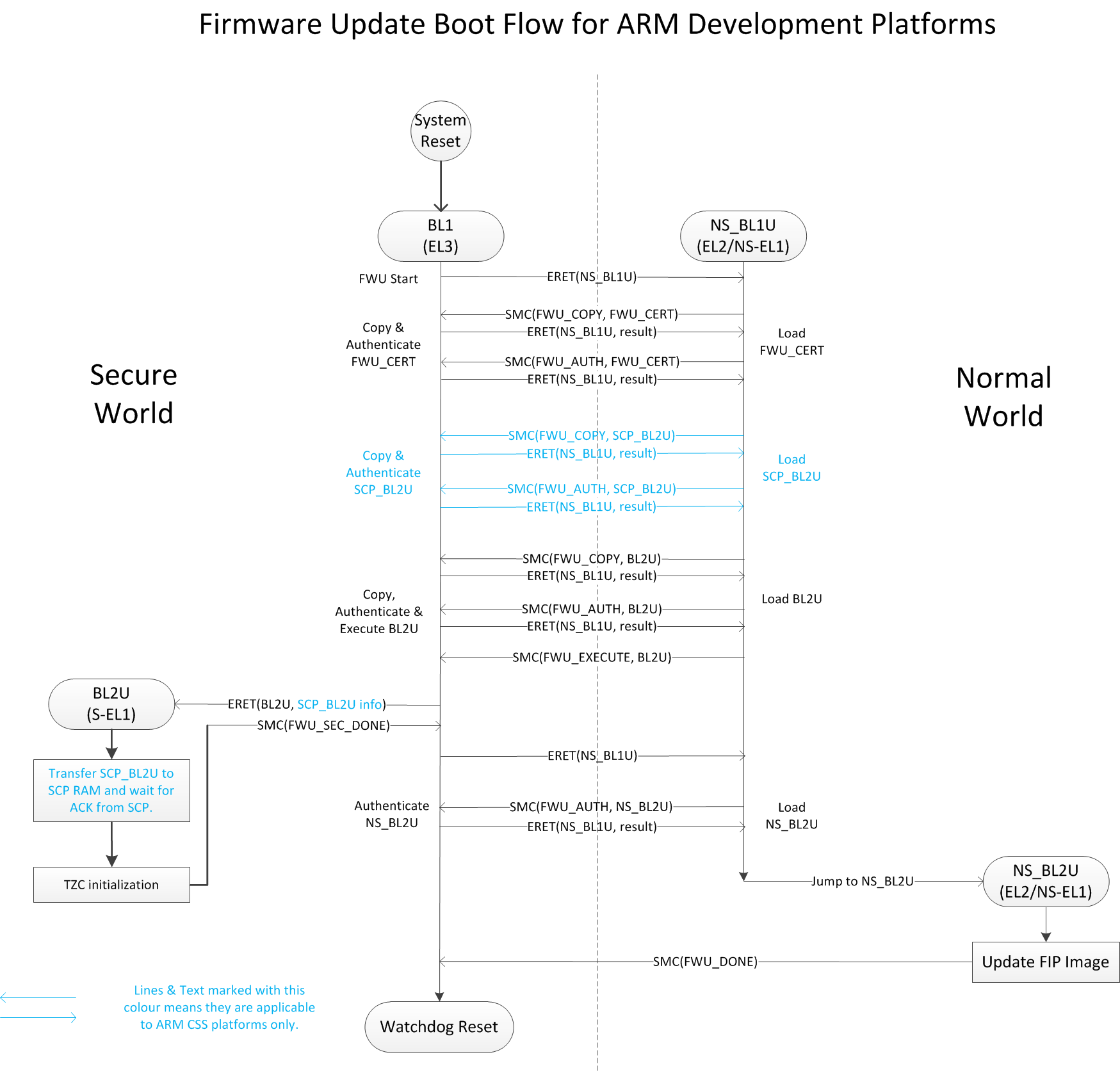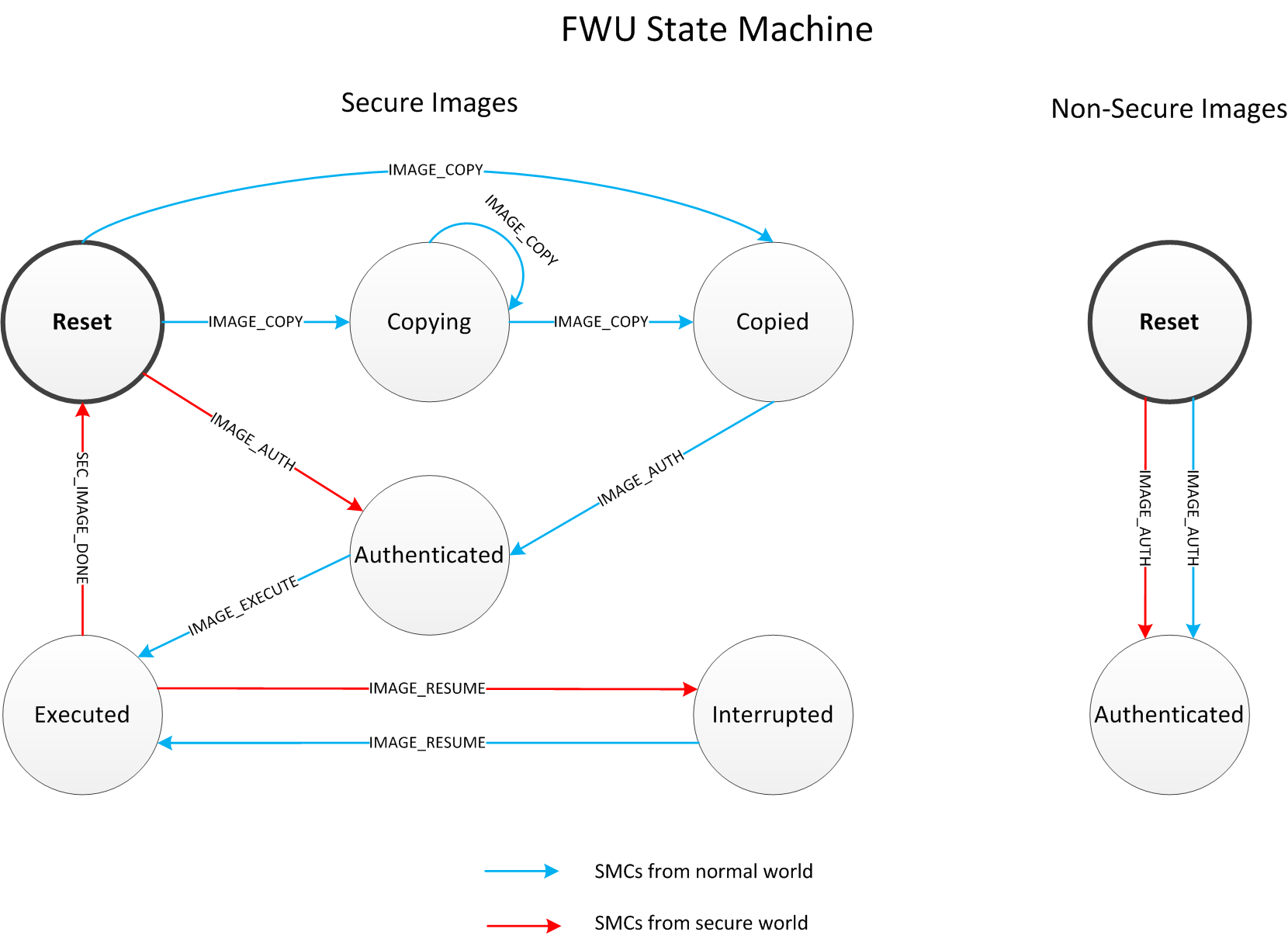6. Firmware Update (FWU)¶
6.1. Introduction¶
This document describes the design of the Firmware Update (FWU) feature, which enables authenticated firmware to update firmware images from external interfaces such as USB, UART, SD-eMMC, NAND, NOR or Ethernet to SoC Non-Volatile memories such as NAND Flash, LPDDR2-NVM or any memory determined by the platform. This feature functions even when the current firmware in the system is corrupt or missing; it therefore may be used as a recovery mode. It may also be complemented by other, higher level firmware update software.
FWU implements a specific part of the Trusted Board Boot Requirements (TBBR) specification, Arm DEN0006C-1. It should be used in conjunction with the Trusted Board Boot design document, which describes the image authentication parts of the Trusted Firmware-A (TF-A) TBBR implementation.
6.1.1. Scope¶
This document describes the secure world FWU design. It is beyond its scope to describe how normal world FWU images should operate. To implement normal world FWU images, please refer to the “Non-Trusted Firmware Updater” requirements in the TBBR.
6.2. FWU Overview¶
The FWU boot flow is primarily mediated by BL1. Since BL1 executes in ROM, and it is usually desirable to minimize the amount of ROM code, the design allows some parts of FWU to be implemented in other secure and normal world images. Platform code may choose which parts are implemented in which images but the general expectation is:
BL1 handles:
Detection and initiation of the FWU boot flow.
Copying images from non-secure to secure memory
FWU image authentication
Context switching between the normal and secure world during the FWU process.
Other secure world FWU images handle platform initialization required by the FWU process.
Normal world FWU images handle loading of firmware images from external interfaces to non-secure memory.
The primary requirements of the FWU feature are:
Export a BL1 SMC interface to interoperate with other FWU images executing at other Exception Levels.
Export a platform interface to provide FWU common code with the information it needs, and to enable platform specific FWU functionality. See the Porting Guide for details of this interface.
TF-A uses abbreviated image terminology for FWU images like for other TF-A images. See the Image Terminology document for an explanation of these terms.
The following diagram shows the FWU boot flow for Arm development platforms. Arm CSS platforms like Juno have a System Control Processor (SCP), and these use all defined FWU images. Other platforms may use a subset of these.

6.3. Image Identification¶
Each FWU image and certificate is identified by a unique ID, defined by the
platform, which BL1 uses to fetch an image descriptor (image_desc_t) via a
call to bl1_plat_get_image_desc(). The same ID is also used to prepare the
Chain of Trust (Refer to the Authentication Framework & Chain of Trust
document for more information).
The image descriptor includes the following information:
Executable or non-executable image. This indicates whether the normal world is permitted to request execution of a secure world FWU image (after authentication). Secure world certificates and non-AP images are examples of non-executable images.
Secure or non-secure image. This indicates whether the image is authenticated/executed in secure or non-secure memory.
Image base address and size.
Image entry point configuration (an
entry_point_info_t).FWU image state.
BL1 uses the FWU image descriptors to:
Validate the arguments of FWU SMCs
Manage the state of the FWU process
Initialize the execution state of the next FWU image.
6.4. FWU State Machine¶
BL1 maintains state for each FWU image during FWU execution. FWU images at lower Exception Levels raise SMCs to invoke FWU functionality in BL1, which causes BL1 to update its FWU image state. The BL1 image states and valid state transitions are shown in the diagram below. Note that secure images have a more complex state machine than non-secure images.

The following is a brief description of the supported states:
RESET: This is the initial state of every image at the start of FWU. Authentication failure also leads to this state. A secure image may yield to this state if it has completed execution. It can also be reached by using
FWU_SMC_IMAGE_RESET.COPYING: This is the state of a secure image while BL1 is copying it in blocks from non-secure to secure memory.
COPIED: This is the state of a secure image when BL1 has completed copying it to secure memory.
AUTHENTICATED: This is the state of an image when BL1 has successfully authenticated it.
EXECUTED: This is the state of a secure, executable image when BL1 has passed execution control to it.
INTERRUPTED: This is the state of a secure, executable image after it has requested BL1 to resume normal world execution.
6.5. BL1 SMC Interface¶
6.5.1. BL1_SMC_CALL_COUNT¶
Arguments:
uint32_t function ID : 0x0
Return:
uint32_t
This SMC returns the number of SMCs supported by BL1.
6.5.2. BL1_SMC_UID¶
Arguments:
uint32_t function ID : 0x1
Return:
UUID : 32 bits in each of w0-w3 (or r0-r3 for AArch32 callers)
This SMC returns the 128-bit Universally Unique Identifier for the BL1 SMC service.
6.5.3. BL1_SMC_VERSION¶
Argument:
uint32_t function ID : 0x3
Return:
uint32_t : Bits [31:16] Major Version
Bits [15:0] Minor Version
This SMC returns the current version of the BL1 SMC service.
6.5.4. BL1_SMC_RUN_IMAGE¶
Arguments:
uint32_t function ID : 0x4
entry_point_info_t *ep_info
Return:
void
Pre-conditions:
if (normal world caller) synchronous exception
if (ep_info not EL3) synchronous exception
This SMC passes execution control to an EL3 image described by the provided
entry_point_info_t structure. In the normal TF-A boot flow, BL2 invokes
this SMC for BL1 to pass execution control to BL31.
6.5.5. FWU_SMC_IMAGE_COPY¶
Arguments:
uint32_t function ID : 0x10
unsigned int image_id
uintptr_t image_addr
unsigned int block_size
unsigned int image_size
Return:
int : 0 (Success)
: -ENOMEM
: -EPERM
Pre-conditions:
if (image_id is invalid) return -EPERM
if (image_id is non-secure image) return -EPERM
if (image_id state is not (RESET or COPYING)) return -EPERM
if (secure world caller) return -EPERM
if (image_addr + block_size overflows) return -ENOMEM
if (image destination address + image_size overflows) return -ENOMEM
if (source block is in secure memory) return -ENOMEM
if (source block is not mapped into BL1) return -ENOMEM
if (image_size > free secure memory) return -ENOMEM
if (image overlaps another image) return -EPERM
This SMC copies the secure image indicated by image_id from non-secure memory
to secure memory for later authentication. The image may be copied in a single
block or multiple blocks. In either case, the total size of the image must be
provided in image_size when invoking this SMC for the first time for each
image; it is ignored in subsequent calls (if any) for the same image.
The image_addr and block_size specify the source memory block to copy from.
The destination address is provided by the platform code.
If block_size is greater than the amount of remaining bytes to copy for this
image then the former is truncated to the latter. The copy operation is then
considered as complete and the FWU state machine transitions to the “COPIED”
state. If there is still more to copy, the FWU state machine stays in or
transitions to the COPYING state (depending on the previous state).
When using multiple blocks, the source blocks do not necessarily need to be in contiguous memory.
Once the SMC is handled, BL1 returns from exception to the normal world caller.
6.5.6. FWU_SMC_IMAGE_AUTH¶
Arguments:
uint32_t function ID : 0x11
unsigned int image_id
uintptr_t image_addr
unsigned int image_size
Return:
int : 0 (Success)
: -ENOMEM
: -EPERM
: -EAUTH
Pre-conditions:
if (image_id is invalid) return -EPERM
if (secure world caller)
if (image_id state is not RESET) return -EPERM
if (image_addr/image_size is not mapped into BL1) return -ENOMEM
else // normal world caller
if (image_id is secure image)
if (image_id state is not COPIED) return -EPERM
else // image_id is non-secure image
if (image_id state is not RESET) return -EPERM
if (image_addr/image_size is in secure memory) return -ENOMEM
if (image_addr/image_size not mapped into BL1) return -ENOMEM
This SMC authenticates the image specified by image_id. If the image is in the
RESET state, BL1 authenticates the image in place using the provided
image_addr and image_size. If the image is a secure image in the COPIED
state, BL1 authenticates the image from the secure memory that BL1 previously
copied the image into.
BL1 returns from exception to the caller. If authentication succeeds then BL1 sets the image state to AUTHENTICATED. If authentication fails then BL1 returns the -EAUTH error and sets the image state back to RESET.
6.5.7. FWU_SMC_IMAGE_EXECUTE¶
Arguments:
uint32_t function ID : 0x12
unsigned int image_id
Return:
int : 0 (Success)
: -EPERM
Pre-conditions:
if (image_id is invalid) return -EPERM
if (secure world caller) return -EPERM
if (image_id is non-secure image) return -EPERM
if (image_id is non-executable image) return -EPERM
if (image_id state is not AUTHENTICATED) return -EPERM
This SMC initiates execution of a previously authenticated image specified by
image_id, in the other security world to the caller. The current
implementation only supports normal world callers initiating execution of a
secure world image.
BL1 saves the normal world caller’s context, sets the secure image state to EXECUTED, and returns from exception to the secure image.
6.5.8. FWU_SMC_IMAGE_RESUME¶
Arguments:
uint32_t function ID : 0x13
register_t image_param
Return:
register_t : image_param (Success)
: -EPERM
Pre-conditions:
if (normal world caller and no INTERRUPTED secure image) return -EPERM
This SMC resumes execution in the other security world while there is a secure image in the EXECUTED/INTERRUPTED state.
For normal world callers, BL1 sets the previously interrupted secure image state
to EXECUTED. For secure world callers, BL1 sets the previously executing secure
image state to INTERRUPTED. In either case, BL1 saves the calling world’s
context, restores the resuming world’s context and returns from exception into
the resuming world. If the call is successful then the caller provided
image_param is returned to the resumed world, otherwise an error code is
returned to the caller.
6.5.9. FWU_SMC_SEC_IMAGE_DONE¶
Arguments:
uint32_t function ID : 0x14
Return:
int : 0 (Success)
: -EPERM
Pre-conditions:
if (normal world caller) return -EPERM
This SMC indicates completion of a previously executing secure image.
BL1 sets the previously executing secure image state to the RESET state, restores the normal world context and returns from exception into the normal world.
6.5.10. FWU_SMC_UPDATE_DONE¶
Arguments:
uint32_t function ID : 0x15
register_t client_cookie
Return:
N/A
This SMC completes the firmware update process. BL1 calls the platform specific
function bl1_plat_fwu_done, passing the optional argument client_cookie as
a void *. The SMC does not return.
6.5.11. FWU_SMC_IMAGE_RESET¶
Arguments:
uint32_t function ID : 0x16
unsigned int image_id
Return:
int : 0 (Success)
: -EPERM
Pre-conditions:
if (secure world caller) return -EPERM
if (image in EXECUTED) return -EPERM
This SMC sets the state of an image to RESET and zeroes the memory used by it.
This is only allowed if the image is not being executed.
Copyright (c) 2015-2019, Arm Limited and Contributors. All rights reserved.